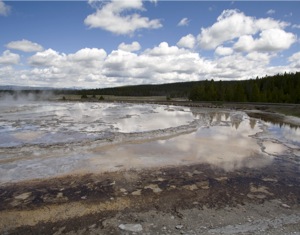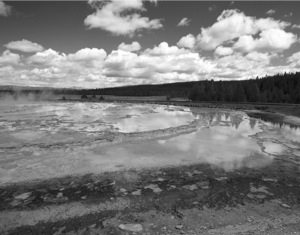Trying Black & White
I have long felt that a good black & white photograph should affect the viewer in such a way that their first thought is something beyond “Where’s the color?”. A color photograph has a broader vocabulary from which to communicate. Saturated colors and color contrasts and juxtapositions can be useful adjectives, but all too often become the nouns in our photography — that is to say, not only is the sky blue, but blue becomes the subject. In black & white, the language is more limited, and the communication depends more heavily on the words of form, composition, texture, value, tonal range and contrast. The great black & white landscape photographer, Ansel Adams, flirted with color through much of his career. A book of his color work was published posthumously, and provides a some strong evidence to support the view that black & white photography is a different medium from color photography, and that these two media involve different ways of “seeing” and different profiles of artistic abilities. Thumbing through the pages of that book, I’m repeatedly struck with the thought “This would make a great black & white photograph!” whereas the color rendition of the scene is somewhat less exciting to me.
I started out as a black & white photographer, because black & white was more tractable and affordable in the home darkroom (especially for a young teenager) than was color. As a young adult, I studied Adams’ Zone System and spent countless hours calibrating my equipment, film, and processing techniques in order to achieve more control over the values in and tonal ranges of my images. Most of my recent work has been color, but every once in a while I see my earlier inclinations shining through as I view an image and think “This would make a great black & white photograph!”.
By way of illustration, the above photograph is rendered in both the original color and a black & white interpretation thereof. Two things are significant in this statement: (1) “the original color”, and (2) “black & white interpretation”. First, although many digital cameras have black & white shooting modes, I find little compelling reason to shoot in black & white mode because the post-processing tools are so capable and flexible that it makes more sense to shoot in color and make some of the decisions in black & white later, thus keeping your options open. Second, black & white rendition represents interpretation. There is no one correct “conversion” of a color image into a black & white image. What shade of grey should this red be? Or, should this red have the same shade of grey as that green? These are the kinds of questions that are possible with black & white (digital or film-based), and are answered through our choices of what filters to use and (in the digital realm) what algorithms to use. Products such as Adobe Photoshop offer film-based contrast filters that can be applied to a color image to produce various black & white interpretations. Newer products, such as Adobe Lightroom, offer even more extensive and interactive controls through which colors get mapped to various shades of grey. Indeed, never before has black & white photography been so forgiving or flexible.
As you review your photographs, if you see images with lackluster color, but interesting composition, tonal range, textures, or forms, try using one of the newer digital tools to produce black & white interpretations. At the very least, you may see things in your work that you’ve never seen before. Who knows? You might have an eye for black & white.

Tip of the Week
2007.01.15


